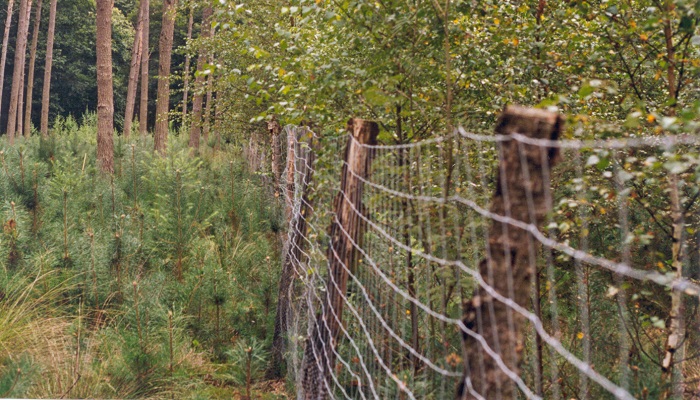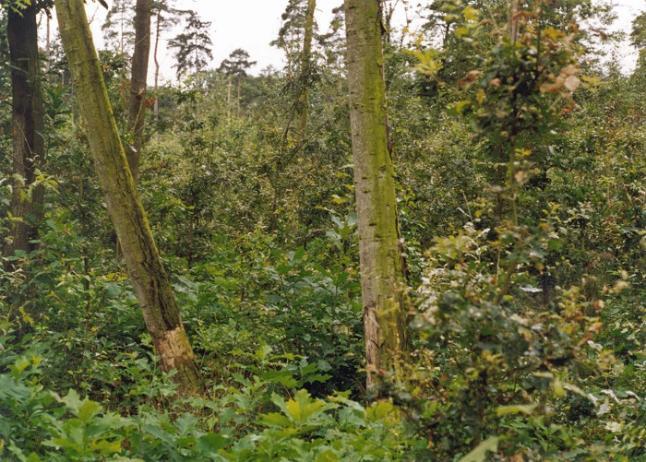13 August 2021
How to improve the biodiversity value of your forest – Part 1

In the first of a two-part series of articles, Steven Meyen, Teagasc Forestry Development Officer talks about how to improve the biodiversity value of your forest. He advises on how to keep browsing animals out, create/leave deadwood and more.
Image above caption: The simplest way to enrich woodland biodiversity is by fencing out browsing animals. In this image, deer do not have access to the area to the right of the fence resulting in much richer natural regeneration (Photo: Teagasc)
A question I get asked regularly is how to make a forest more ecologically valuable. Increasing the biodiversity value of a forest may sound a daunting task but it is not. There are a couple of simple things you can do that will make a world of difference.
Keep browsing animals out
The very first job to do is to put a sturdy fence around the forest to keep out animals. Animals such as deer, cattle, sheep, horses, goats, pigs and rabbits will cause a lot of damage to trees.
They will strip the bark off the tree thereby rendering the tree’s timber commercially worthless while giving pests and diseases a helping hand to infect the tree.
A healthy, well-structured forest should consist of grandparent trees, parents, teenage children and baby trees. Animals will happily graze the baby trees (i.e. the natural regeneration) thereby destroying the forest’s next generation.
Too many animals will compact the soil leading to reduced biological activity, porosity and permeability of the soil. Especially in Ireland, soil compaction can be a serious issue because of our damp climate. This tends to lead to increased surface run-off, flooding, erosion, nutrient loss as well as poor root development.
Animals can also cause drainage issues by damaging and collapsing mound drains.
Restricting access will very quickly turn your forest into a rich woodland.
Create / leave deadwood
Trees not only provide many different functions when alive, they continue to do so when dead. Many fungi, bacteria, lichens, mosses, insects such as beetles and birds (e.g.: owls) depend on dead trees as a very important source of food, shelter or as nesting sites.
The not-so-impressive fungi and bacteria fulfil an extremely important role in every woodland by recycling nutrients and enriching soils.
Both standing and lying dead trees are essential links in any healthy woodland ecosystem cycle.
If very little dead wood is present, consider cutting down a few mature trees to create lying deadwood. Don’t cut down top quality trees to create lying deadwood instead choose poorly formed trees. The wood can then be stacked to create a ‘bug hotel’.
The ecological importance of standing deadwood is often overlooked. If no appropriate standing dead trees are around, you can mimic this by ring-barking a poorly formed or undesirable tree.

Image caption: These trees have been ringbarked to create standing deadwood, a vital element in any woodland ecosystem (Photo: Teagasc)
Encourage weeds
An ecologically rich woodland is a haven for wildlife where “weeds” are welcomed and needed. Such plants contribute greatly to a woodland’s biodiversity.
Nettles support fifteen different moth species and provide food for butterflies. Briars offer food to forty different species of butterfly and moth. They are valuable groundcover and food to many birds.
Elder comes into leaf very early in spring providing early cover for birds. Its berries are an important food source for birds in late summer.
Ivy is loved and hated in equal measure! However, it does play a very important role in wooded ecosystems and should be retained as a valuable food source. It flowers very late in the season thereby providing one of the very few food sources for bees. Its berries ripen after Christmas providing a critically important food source for birds in late winter when very few other food sources are (still) available.
Removal of ivy should only be considered for safety reasons where ivy is free flowering in roadside tree crowns. This will lead to top-heavy trees making them more likely to blow down in a storm. A handy rule of thumb for dealing with ivy on roadside trees is that it should be removed for safety reasons when reaching the lower branches of the crown.
You might also like to read How to improve the biodiversity value of your forest – Part 2 , where Steven Meyen, Teagasc Forestry Development Officer looked at the importance of tree species, open spaces and interconnectivity.
The Teagasc Forestry Department issues an article on a Forestry topic every Friday here on Teagasc Daily
Subscribe to: Forestry e-News
Keep up-to-date with the Teagasc Forestry Department here or follow them on Social Media here
